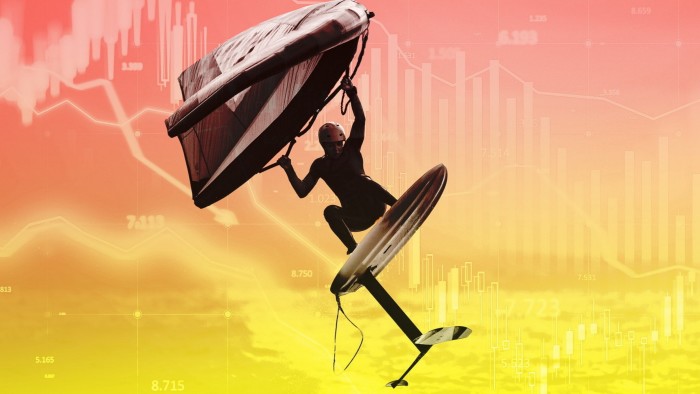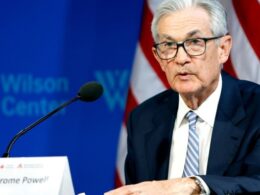Unlock the Editor’s Digest for free
Roula Khalaf, Editor of the FT, selects her favourite stories in this weekly newsletter.
With four young kids and a wife with selective mechanophobia, one half of my Easter holidays was spent loading and unloading the dishwasher. No matter how often I left the knives facing upwards, no one else saw the point.
The other half was no more fun. I was learning to wing foil in the frigid water off England’s south coast. And so often did I crash that my store of Australian swear words ran dry. That’s never happened before.
I mention this as I had lots of time to ponder what to do with my portfolio as the tide swept me towards Brighton. What is more, I realised that riding a foil is a useful metaphor when markets are choppy.
That’s because both share the same conflicting advice. “Less is more,” stress many foilers. Staying up is about being calm, not moving around on the board and gliding smoothly over the waves below.
Rubbish, say some instructors. Work the foil. Constantly push it around so you’re always ready to shift with the sea and wind. Proactive not reactive. Be on the front foot. Literally.
I was similarly conflicted with my funds. Should I keep still and wait for the Orange Crash to blow through? This column has explained often the benefits of staying invested when prices tumble.
On the other hand, my favourite investments were being battered. I’d be foolish not to buy more of them, right? Asset values were up and down from one day to the next. Ride the waves hard, man.
I chose the latter approach. Which may come as a surprise given the bugger all moves in my portfolio over the past year or so. But markets then were calm. I liked what I had. No opportunities arose.
Did they ever in April, though? My beloved Japanese equities fell 13 per cent in a matter of days. Likewise, the unit price of my Asia fund dropped from £145 to £125 in a week. Shares in the UK went splosh, too.
I’ve already said that I’m adding to the latter via the purchase of a FTSE 250 exchange traded fund. You will remember from my first-ever column that I have to wait 30 days before doing so.
The same rules mean I cannot tell you for a month what, if anything, I have bought or sold already. But rest assured I have — and managed to nab some reasonable entry and exit points to boot. My portfolio return is actually positive year to date.
All will be revealed in the coming weeks. And, while being a few shillings in the black won’t buy me a new wetsuit, it’s better than being 15 per cent down — as the S&P 500 is in sterling terms.
A fortnight ago I explained why paying almost a fifth less for US shares is still not enough of a valuation discount as far as I’m concerned. On top of that, I worry that earnings forecasts remain gaga.
For example, consensus growth for 2025 is 7.9 per cent year on year, according to Bloomberg data. Sure, that’s down from 10 per cent a month ago and 12 per cent in January. But it’s above the 7.7 per cent average since 2010.
Meanwhile, US profit margins hit a record high in March and have only been revised down by 70 basis points since. Most strategists I have read calculate tariffs will knock off 10 times as much this year.
So I won’t be buying US stocks for a while. The bigger problem I had was not having any spare cash in my portfolio. If I wanted to top up on funds that had fallen, therefore, I had to sell others — even if I liked them.
Hence for me investing was a relative game all of a sudden. Which of my beloved funds did I now love the least? An impossible question: like choosing between children or The Stones and Stevie Wonder versions of the song “I Don’t Know Why”.
Again, I’ve already mentioned that my energy fund is going to get the chop. As you can see below, it’s done relatively well since the meltdown but, frankly, the amount I own is too small to matter much.
Then the choice is between selling a lot of one fund or top-slicing a few. When making that decision it’s best in my view to compare valuations to see if there is an outlier, or whether they are all much of a muchness.
Looking at my equity funds, it is interesting to see how price-to-earnings ratios have moved. The numerator has obviously fallen across the board versus a month ago. But downward revisions to earnings mean that PE ratios in Japan and the UK, for example, are no lower.
That is not the case for my Asia EM fund, however, which is now about 15 per cent cheaper on an earnings basis. And for all three regions, estimates for second-quarter operating margins are considerably higher than in March.
Currency swells are the final things to read. It has helped that my portfolio is less exposed to the greenback than most. Conversely the fact my funds are denominated in a higher sterling has been a headwind.
But my Japan fund is down less than 5 per cent since January even though the yen has risen. Usually export-heavy Japan underperforms when the yen is strong. Likewise FTSE 100 companies, which are up 3.3 per cent in pounds.
I consider these to be anomalous wins. Hence both should do better yet if the dollar recovers some lost ground. So I could have added to either region, frankly, but only chose one in the end.
If only wing foiling was so easy.
The author is a former portfolio manager. Email: stuart.kirk@ft.com; X: @stuartkirk__









